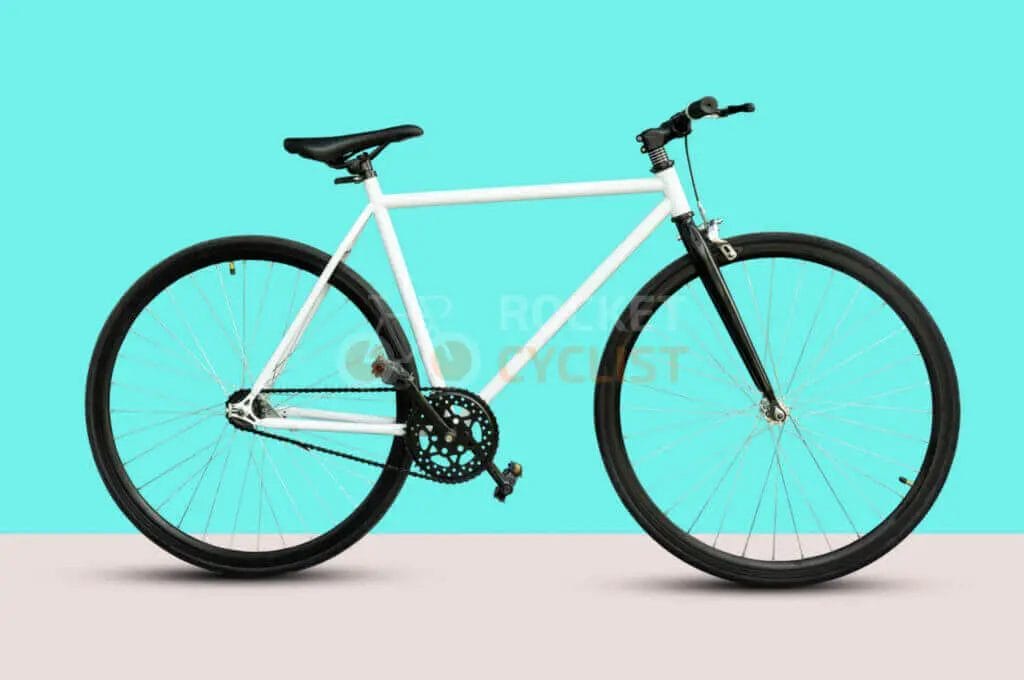Last Updated on February 10, 2024 by Vinson Lozano

If you’re in the market for a new bike and are trying to decide between a fixed gear or a road bike, then you’ve come to the right place. In this article, we will provide you with a comprehensive understanding of the differences between fixed gear and road bikes. Whether you’re a seasoned cyclist or just starting out, it’s important to choose the right type of bike that aligns with your needs and preferences. By the end of this article, you will have a clear understanding of the benefits, advantages, and disadvantages of each type of bike. So let’s dive in and explore the world of fixed gear and road bikes!
Overview of fixed gear and road bikes
Fixed gear bikes, also known as fixies, are bicycles that have a single gear ratio and no freewheel mechanism. This means that the pedals are always in motion and the rider cannot coast. These bikes are often preferred by urban cyclists and athletes seeking simplicity and a unique riding experience.
Road bikes, on the other hand, are designed for fast and efficient riding on paved surfaces. They typically have multiple gears, drop handlebars for a more aerodynamic position, and skinny tires for reduced rolling resistance. Road bikes are commonly used for long-distance rides, racing, and training.
Both fixed gear and road bikes have their own unique characteristics, and understanding their differences can help you determine which one is the best fit for your riding style and preferences.
Benefits of choosing either type of bike
Choosing either a fixed gear or road bike can offer a range of benefits based on your preferences and riding style.
Fixed gear bikes provide a unique and intimate riding experience. Their simplicity and direct power transfer make them ideal for urban commuting, as they require less maintenance and are less likely to be stolen due to their lack of gears. Fixed gear bikes also offer a greater sense of control and precision, allowing riders to feel more connected to the road.
On the other hand, road bikes are designed for speed and efficiency. With their multiple gears, aerodynamic handlebars, and lightweight frames, road bikes excel on long-distance rides, racing, and training. They offer a smooth and fast ride, making it easier to cover larger distances with less effort.
Ultimately, the choice between a fixed gear or road bike depends on your personal preferences, riding goals, and the type of terrain you will be riding on.
Fixed Gear Bikes

Fixed gear bikes, also known as fixies, are bicycles that have a drivetrain with only one gear, and the rear wheel is directly connected to the pedals. This means that whenever the pedals turn, the bike moves forward. Fixed gear bikes offer a unique and intimate riding experience. With their simplicity and direct power transfer, they are ideal for urban commuting, as they require less maintenance and are less likely to be stolen. Fixed gear bikes also provide a greater sense of control and precision, allowing you to feel more connected to the road. However, it’s important to note that fixed gear bikes require practice and skill to ride effectively, as you have to resist the forward motion of the pedals to slow down or stop. Overall, fixed gear bikes offer a minimalist and engaging riding experience.
Fixed gear bikes explained
Fixed gear bikes, also known as fixed-wheel or fixie bikes, have a simple and minimalist design. They consist of a single gear ratio, with the pedals directly connected to the rear wheel. This means that whenever you pedal forward, the wheel moves forward as well. There is no freewheel mechanism, so you cannot coast or pedal backward. The simplicity of their drivetrain makes fixed gear bikes lightweight and low-maintenance. They offer a direct connection between your pedaling power and the bike’s movement, giving you a more engaging riding experience. Fixed gear bikes are popular among urban commuters, track riders, and cycling enthusiasts who enjoy the challenge and control of riding without gears.
Advantages of fixed gear bikes
Fixed gear bikes offer several advantages that make them a popular choice for many cyclists. Here are some of the key advantages:
- Simplicity: With fewer components, fixed gear bikes are straightforward and easy to maintain. This simplicity also makes them lighter, allowing for a more agile and responsive ride.
- Control: The direct connection between your pedaling and the bike’s movement gives you a heightened sense of control. You have the ability to control your speed and cadence precisely, allowing for a more engaging and connected riding experience.
- Fitness and Strength: Riding a fixed gear bike requires constant pedaling, which can help improve your endurance, leg strength, and overall fitness level.
- Urban Agility: Fixed gear bikes’ lightweight and maneuverable nature make them ideal for navigating busy city streets and traffic.
- Affordability: Fixed gear bikes tend to be more affordable compared to road bikes, making them a budget-friendly option for cycling enthusiasts.
- Style: Fixed gear bikes have a unique and minimalist aesthetic that appeals to many cyclists looking for a sleek and stylish ride.
Overall, if you value simplicity, control, fitness, and urban agility, a fixed gear bike may be the perfect choice for you.
Disadvantages of fixed gear bikes
While fixed gear bikes offer numerous advantages, it’s important to consider the potential disadvantages as well. Here are a few drawbacks to keep in mind:
- Limited gear range: Fixed gear bikes have a single gear ratio, which means you may struggle with steep hills or long distances on flat terrain.
- Lack of coasting: With no freewheel mechanism, you must constantly pedal, even when going downhill or wanting a momentary break.
- Strenuous on the body: The continuous pedaling can put additional strain on your knees and hip flexors, which may not be suitable for everyone or for long rides.
- Limited braking options: Fixed gear bikes typically have only one front brake, which may not offer as much stopping power as dual-brake road bikes.
It’s important to weigh these disadvantages against the benefits to determine if a fixed gear bike aligns with your preferences and riding style.
Road Bikes

Road bikes are designed for speed and efficiency on paved roads. They typically have lightweight frames, narrow tires, and multiple gears. Road bikes are ideal for long distance riding, racing, and high-speed cycling.
Advantages of road bikes include their versatility and ability to handle different terrains. They provide a smooth and comfortable ride, thanks to features such as suspension systems and padded seats. Road bikes also offer a wider range of gears, allowing riders to tackle various gradients with ease.
However, road bikes have some disadvantages. They can be expensive and require regular maintenance. The thin tires may be more prone to punctures, and the aggressive riding position may not be comfortable for everyone, especially those with back or neck issues.
Overall, road bikes are a great choice for cyclists looking for speed, efficiency, and the ability to cover long distances on paved roads.
Road bikes explained
Road bikes are designed specifically for riding on paved roads and are known for their speed and efficiency. They have lightweight frames made from materials like aluminum or carbon fiber, which helps to reduce weight and increase agility. Road bikes also feature narrow tires with higher pressure, allowing for less rolling resistance and faster speeds. These bikes typically have drop handlebars that promote an aerodynamic riding position, enhancing speed and reducing wind resistance. They also come equipped with a wide range of gears, allowing riders to easily tackle various terrains and gradients. Overall, road bikes are the perfect choice for those seeking fast and efficient rides on paved surfaces.
Advantages of road bikes
Road bikes offer several advantages that make them a popular choice among cyclists.
- Speed and Efficiency: Road bikes are designed for maximum speed and efficiency on paved roads. Their lightweight frames and narrow tires with high pressure allow for less rolling resistance, enabling riders to achieve higher speeds with less effort.
- Versatility: Road bikes are versatile and well-suited for various types of riding. Whether you’re training, commuting, or participating in a race, a road bike can handle it all. They offer a wide range of gears, allowing you to tackle different terrains and gradients with ease.
- Aerodynamics: Road bikes feature drop handlebars that promote an aerodynamic riding position, reducing wind resistance and making them faster. This design allows riders to maintain higher speeds for longer periods.
- Long-Distance Comfort: Road bikes are designed with long-distance cycling in mind. They typically have more relaxed geometry and features like padded saddles and shock-absorbing components, which provide greater comfort during extended rides.
- Improved Fitness: Riding a road bike regularly can improve cardiovascular health, build endurance, and increase overall fitness levels. The combination of speed, distance, and varied terrains offers an excellent cardiovascular workout.
In summary, road bikes provide speed, efficiency, versatility, comfort, and fitness benefits that make them a great choice for cyclists seeking high-performance rides on paved surfaces.
Disadvantages of road bikes
While road bikes offer numerous advantages, they also have some drawbacks to consider. Here are a few disadvantages of road bikes:
- Cost: Road bikes can be quite expensive, especially high-end models with advanced features. This may make them less accessible to some individuals on a tight budget.
- Limited Off-Road Capability: Road bikes are primarily designed for paved surfaces, so they may struggle on rough or unpaved terrain. If you enjoy off-road or trail riding, a road bike may not be the best choice.
- Less Comfortable for Longer Rides: The aggressive riding position and stiff frame of road bikes may cause discomfort or fatigue during long rides. The emphasis on speed and efficiency can compromise comfort, especially for riders who prefer a more upright posture.
- Reduced Stability: Road bikes have a lighter and more maneuverable design, which can make them less stable at high speeds or in adverse weather conditions. Novice riders may find them slightly more challenging to handle compared to other types of bikes.
- Limited Carrying Capacity: Road bikes typically have minimal storage options, with limited mounting points for racks or panniers. This can be limiting if you need to carry a significant amount of gear or luggage.
Overall, while road bikes excel in certain areas, they may not be the best fit for everyone, particularly those who prioritize comfort, off-road capability, or carrying capacity. It’s important to weigh the disadvantages against the advantages and consider your specific needs and preferences before making a decision.
Key Differences
Now that we have a better understanding of fixed gear and road bikes, let’s discuss the key differences between these two types of bicycles.
- Gear Systems: Fixed gear bikes have a single gear ratio, meaning that the pedals are directly connected to the rear wheel. This setup provides a more simplified riding experience and requires constant pedaling. On the other hand, road bikes typically have multiple gears, allowing riders to adjust their pedaling resistance and speed based on the terrain.
- Braking Mechanisms: Fixed gear bikes usually have a straightforward braking system called a “fixed gear brake.” This requires the rider to apply backward pressure on the pedals to slow down or stop. Road bikes, on the other hand, commonly use rim brakes or disc brakes, providing more efficient and reliable stopping power.
With these key differences in gear systems and braking mechanisms, it’s important to consider your riding preferences and the terrain you plan to tackle when choosing between a fixed gear and road bike.
Differences in gear systems
Fixed gear bikes have a simple gear system with a single gear ratio. This means that the pedals are directly connected to the rear wheel, giving you a direct and immediate transfer of power. With no gears to shift, you’ll need to constantly pedal to maintain momentum. On the other hand, road bikes come equipped with multiple gears. These gears allow you to adjust the pedaling resistance, making it easier to climb steep hills or go faster on flat roads. The ability to shift gears provides versatility and adaptability to different terrains and riding conditions. Whether you prefer the simplicity of a fixed gear or the versatility of multiple gears, the choice ultimately depends on your personal preference and riding needs.
Differences in braking mechanisms
When it comes to braking mechanisms, fixed gear bikes and road bikes have distinct differences. Fixed gear bikes typically feature only one braking option: a traditional front or rear brake that is activated by pulling a lever. On the other hand, road bikes often come equipped with a dual braking system. This includes both front and rear brakes, giving you more control and stopping power. Additionally, road bikes may have additional braking mechanisms such as disc brakes or rim brakes, which provide different levels of stopping power and modulation. The choice of braking mechanism depends on your preference for simplicity or the need for more advanced braking capabilities.
Which Bike is Right for You?
When it comes to choosing the right bike for you, there are a few factors to consider. Firstly, think about your riding style and needs. If you prefer simplicity and a more connected riding experience, a fixed gear bike might be the perfect choice. On the other hand, if you enjoy longer rides, varied terrains, and the ability to switch gears for different speeds, a road bike may be more suitable. Consider your fitness level, the types of rides you’ll be doing, and your comfort preferences. It’s important to test ride both types of bikes to see which one feels the most comfortable and aligned with your goals. Ultimately, the right bike for you will be the one that brings you the most joy and suits your riding ambitions.
Factors to consider when choosing a bike
When choosing a bike, there are several factors to consider. Firstly, assess your riding style and needs. Think about whether you prefer simplicity and a more connected riding experience with a fixed gear bike, or if you enjoy longer rides and varied terrains with a road bike. Consider your fitness level and the types of rides you’ll be doing. Additionally, think about your comfort preferences and test ride both types of bikes to see which one feels the most comfortable. Finally, also take into account factors like your budget and maintenance requirements. By considering these factors, you can find the bike that best suits you.
Matching the bike to your riding style and needs
When it comes to choosing a bike, it’s important to match it to your riding style and needs. Consider the type of rides you’ll be doing and the terrain you’ll be covering. If you prefer simplicity and a more connected riding experience, a fixed gear bike might be the right choice for you. On the other hand, if you enjoy longer rides and varied terrains, a road bike would be more suitable. Take into account your fitness level and comfort preferences as well. Test ride both types of bikes to see which one feels the most comfortable. Lastly, consider factors like your budget and maintenance requirements before making your final decision. By taking all these factors into consideration, you can find the bike that best suits your riding style and needs.
Conclusion
In conclusion, when choosing between a fixed gear or a road bike, it is important to consider your riding style and needs. Fixed gear bikes offer simplicity and a connected riding experience, while road bikes are suitable for longer rides and varied terrains. Both types have their advantages and disadvantages, such as gear systems and braking mechanisms. Ultimately, it comes down to personal preference and what best aligns with your fitness level and comfort needs. By taking into account factors like your budget and maintenance requirements, you can make an informed decision. Test ride both types of bikes to see which one feels right for you.
Summary of key points
In summary, when considering whether to choose a fixed gear or a road bike, it’s crucial to evaluate the benefits and drawbacks of each. Fixed gear bikes provide simplicity, a connected riding experience, and better control while riding on flat terrains. On the other hand, road bikes are versatile, suitable for varied terrains, and better equipped for longer rides. The key differences lie in the gear systems and braking mechanisms. Fixed gear bikes have a single-speed gear system and rely on your leg power to control speed, while road bikes offer multiple gears for easier climbing and faster speeds. When making a decision, consider factors like your riding style, terrain, budget, and maintenance requirements. A test ride will help you determine which bike suits you best. Overall, choose the bike that aligns with your preferences and needs.
Final thoughts and recommendations
In conclusion, both fixed gear and road bikes have their own advantages and disadvantages. The choice between the two ultimately comes down to your personal preferences and needs. If you value simplicity, a connected riding experience, and better control on flat terrains, a fixed gear bike may be the right choice for you. On the other hand, if versatility, varied terrains, and longer rides are what you seek, a road bike is the way to go. Consider factors such as your riding style, terrain, budget, and maintenance requirements when making your decision. And most importantly, take the time to test ride both types of bikes to see which one feels more comfortable and suits your needs best.


